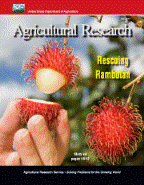United States Department of Agriculture: Agricultural Research Service, Lincoln, Nebraska

Agricultural Research Magazine
Date of this Version
2-2012
Document Type
Article
Citation
Agricultural Research Magazine 60(2): February 2012 pp. 14-15; ISSN 0002-161X
Abstract
In western parts of the United States where some rugged ranges can only be reached by horseback, ranchers often find themselves saddling up weekly to deliver mineral supplements to livestock grazing in nutrient-deficient regions, especially areas scarce in selenium. The routine is not only time-consuming but also costly, and in some leased-land arrangements, such supplementation practices are prohibited.
Selenium, a trace mineral and component of important selenoprotein antioxidants, is essential for good health in livestock and humans. If the body cannot form these important antioxidant proteins, it predisposes the animal to sickness and eventually death at a young age.
Selenium deficiency in livestock affects more than 35 states and costs sheep, beef, and dairy producers an estimated $545 million in losses each year. Lack of adequate selenium in sheep reduces conception rates, increases neonatal mortality, and in some instances, causes white muscle disease—nutritional muscular dystrophy. Lambs that do survive suffer from increased disease, reduced weight gain, and impaired performance.
Included in
Agriculture Commons, Animal Sciences Commons, Food Science Commons, Plant Sciences Commons

